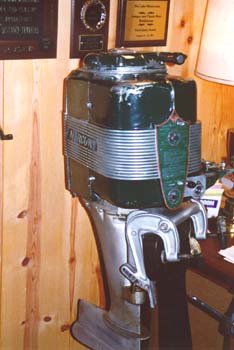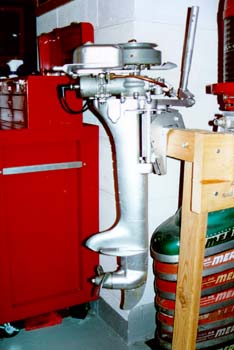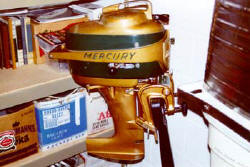by Chuck Petersen
The three most common questions I hear at boat shows are the following: 1). What is that? 2). How fast does it go? and 3). What is it worth? Outboard motors, similar to wooden boats, are valued by the simple laws of supply and demand. Yet, some fairly common models like Mercury kg-7 Super 10 and Johnson 5 hp green TD models are fairly pricey in restored condition. Some rare, often low horse power, brands like Flambeau or Elgin are easy to bargain for. Horsepower alone is not a good pricing guide. A diminutive horsepower Clarke  troller is a high dollar item while a 1950s Johnson V-4 50 h.p. is not worth $1.00 per pound! The key seems to be each model/manufacturers impact over time to excite the market. This market is largely made up of baby-boomer collectors that form a clear affinity for the models that made a lasting impression early in life. The memories of a full-race Mercury KG9-H screaming across the lake at then unheard of speeds or fishing all day with a red Johnson 10 hp QD model last a long time. They were simply the best examples in each category available in their era.
troller is a high dollar item while a 1950s Johnson V-4 50 h.p. is not worth $1.00 per pound! The key seems to be each model/manufacturers impact over time to excite the market. This market is largely made up of baby-boomer collectors that form a clear affinity for the models that made a lasting impression early in life. The memories of a full-race Mercury KG9-H screaming across the lake at then unheard of speeds or fishing all day with a red Johnson 10 hp QD model last a long time. They were simply the best examples in each category available in their era.
While most participants in the world of outboard motor collecting find a niche based on personal preference, i.e. life experience, outward appearance or even accessories, a few pricing principles hold true.
1). If it was a racing model with documented competition history, buy it!!!. With some clear exceptions like the Mercury mk20H and Champion High Speed models, most race motors of the 1950s were nearly identical to their fishing counterparts in power head design. The short tower housing and torpedo gear cases built in limited number was the key defining feature. Race models, like their American muscle car counterparts, often fetch 10 times the value of a similar vintage standard model.
2).  Historical significance. Names like Waterman, Johnson, Elto, Mercury and Chris Craft are significant to the industry for various reasons. Models in their respective lines that represented technology break-throughs for the respective eras are sought after by collectors. Examples of this include early Kiekhaffer Mercurys and break out designs like the six cylinder Tower of Power mk75 or 4 cylinder kg-9mk40 models.
Historical significance. Names like Waterman, Johnson, Elto, Mercury and Chris Craft are significant to the industry for various reasons. Models in their respective lines that represented technology break-throughs for the respective eras are sought after by collectors. Examples of this include early Kiekhaffer Mercurys and break out designs like the six cylinder Tower of Power mk75 or 4 cylinder kg-9mk40 models.
3). Finally
Complete, original parts motors are key. Even novice collectors can spot a bad paint job, missing or non-original parts or poor workmanship a mile away. The key for me is to buy what you really want and will actually use on occasion. Dont be swept up in looking for a deal on a motor that will sit on a corner of the garage for years. Do buy parts motors in less than pristine condition of models you plan to restore and use. The spare parts can be neatly stored and classified for future needs and take up a minimum of space. Some examples I feel will grow in value in the near future include recent era race models, some still in competition, like 1970s 1980s Mercury models and 1980s 1990s OMC mills. Also Art Deco late 1950s, early 1960s motors like the Fire Hat Merc. 28 and 10 hp models are picking up steam. While these were merely a stepping stone in technology between classic 1950s models and modern power plants, their unique design and paint jobs really catch the eye. 
In closing, enjoy the hobby by doing as much work as possible yourself and consider parts availability for user models. Enjoy the off-season shop time!

